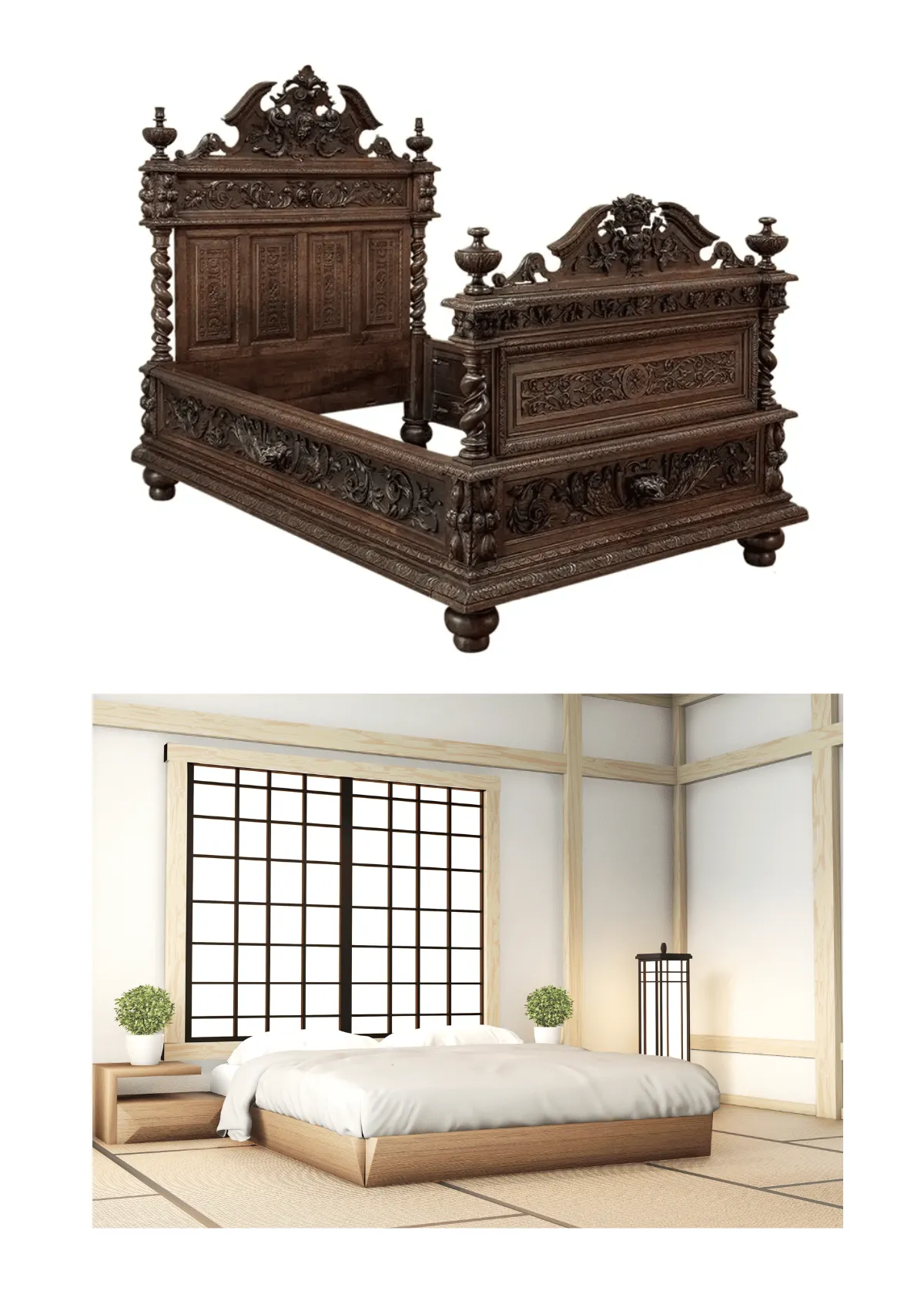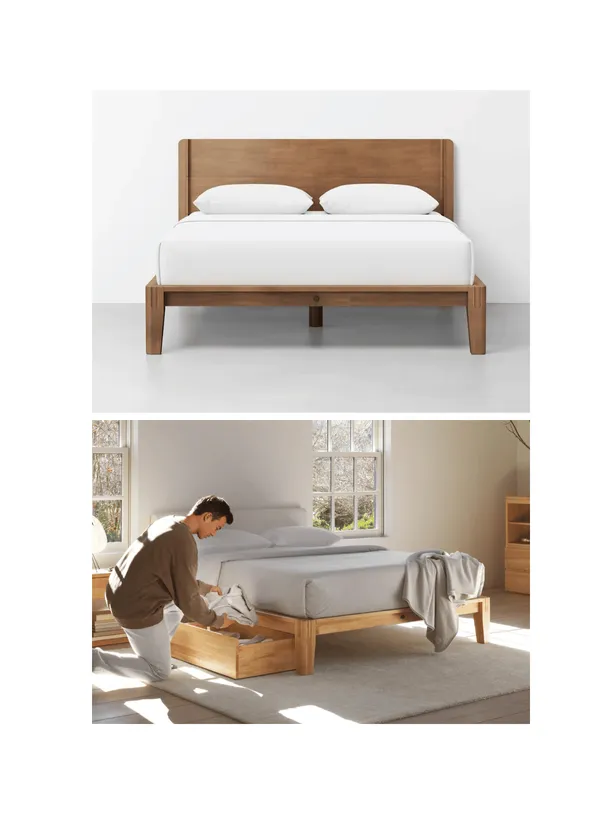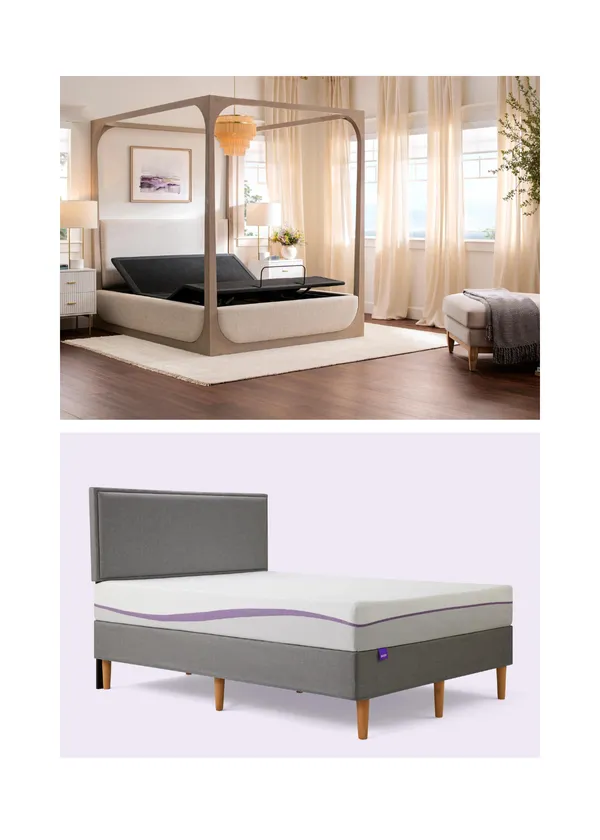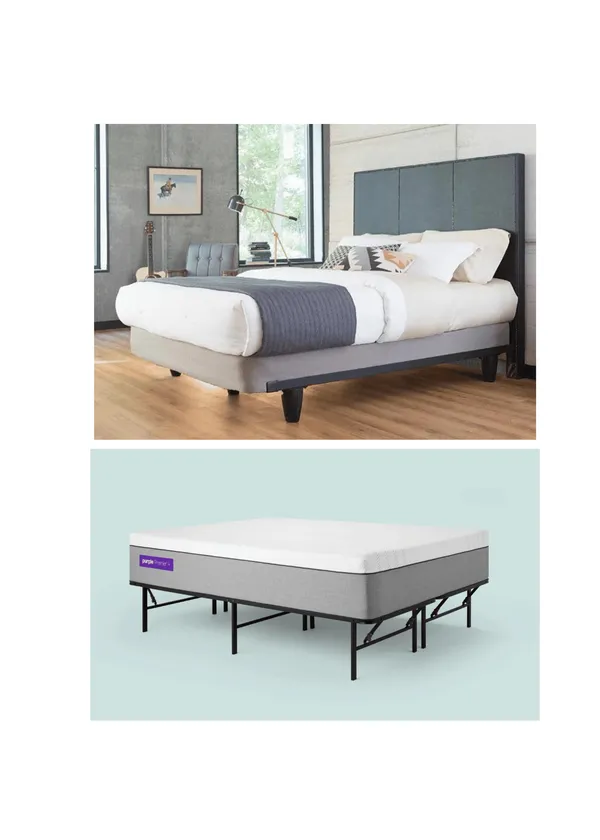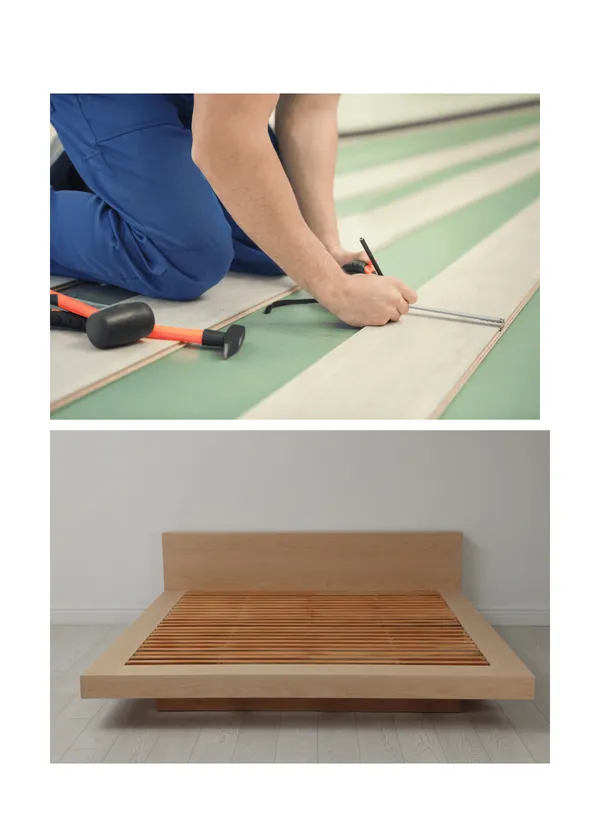Have you ever wondered how bed frames have transformed over the centuries from simple wooden structures to sleek, modern designs?
In this article, I will reveal the captivating evolutionary journey of bed frames, underlining their crucial role in supporting mattresses and significantly enhancing our sleep experience.
We’ll briefly journey through history to see how styles and materials have changed and provide a comprehensive overview of today's innovative designs.
Join us as we delve into bed frames' past, present, and future.
Ancient Bed Frames: The Origins
What I find fascinating about the origins of bed frames is their simplicity and the ingenuity of early civilizations.
The earliest bed frames, dating back to 3000 BCE, were essentially raised platforms designed to keep sleepers off the cold, damp ground.
Made from wood, stone, or woven reeds, these primitive structures marked the beginning of the transformation of bed frames. Early designs were minimalistic, focusing primarily on functionality rather than aesthetics.

Egyptian and Mesopotamian Bed Frames
Ancient Egypt and Mesopotamia bed frames were significantly more advanced than their predecessors. Egyptian bed frames, often crafted from wood, were elevated and featured legs shaped like animal limbs, symbolizing strength and divinity.
On the other hand, Mesopotamian bed frames utilized intricate carvings and metal inlays. These beds were not just functional pieces but also status symbols.
Bed Frames in Ancient Rome and Greece
Bed frames began to evolve in design and comfort in ancient Greece and Rome. Greek beds were often adorned with elaborate headboards and footboards, while Roman beds included metal frames and luxurious cushions.
I am fascinated by how these ancient cultures viewed bed frames as essential components of their domestic life, integrating comfort and artistry into their sleeping arrangements.
Medieval Bed Frames: Symbolism and Functionality
- Medieval bed frames blended symbolism and functionality. During this period, beds were often large and ornately carved, reflecting the social status of their owners.
- Materials like oak and walnut were commonly used, and construction techniques became more sophisticated. Canopy beds and four-poster beds emerged, providing both private space and warmth. These beds often featured heavy drapery.
Renaissance Bed Frames: Artistry and Craftsmanship
The Renaissance saw a resurgence of artistry and craftsmanship in bed frame design. Influenced by the art and architecture of the time, bed frames became masterpieces of intricate design and ornamentation. What I find compelling about Renaissance bed frames is the level of detail and the incorporation of motifs from classical art.
Colonial and Early American Bed Frames
- Their simplicity and practicality characterized Colonial and Early American bed frames.
- Early settlers in America prioritized functionality, often using locally sourced wood like pine and oak to craft their bed frames.
Victorian Bed Frames: Sofa Beds, Opulence and Innovation
The Victorian era brought a wave of luxury and innovation to bed frame design. Victorian bed frames were renowned for their elaborate details and exquisite designs. This period saw the introduction of metal bed frames, like metal bed springs.
- The Industrial Revolution significantly impacted the production of bed frames, making them more accessible and varied.
- Sofa beds were invented in the late 19th century.
- Leonard C. Bailey filed the earliest known patent for a convertible bed, which could be transformed from a sofa into a bed in 1899.
The Victoria and Albert Museum inaugurated in 1852, showcases art and design from the 5,000-year history of beds. It has extensive collections of ceramics, fashion, textiles, and more in London.
Early 20th Century Bed Frames: Transition and Transformation
As we move into the early 20th century, bed frames underwent a significant transformation influenced by the Art Deco and Art Nouveau movements. These styles introduced bold geometric patterns and organic shapes.

Mid-Century Modern Bed Frames: Simplicity and Function
Characteristics of Mid-Century Design
The mid-century modern era brought a profound shift in bed frame design, characterized by simplicity and function. What I find compelling about this period is the importance of clean lines, organic forms, and minimal ornamentation.
Popular Materials and Techniques
Popular materials included teak, walnut, and oak, often combined with metal accents to create a sleek, modern look. Scandinavian design was particularly strong, focusing on practicality and beauty. Many brands continue to draw inspiration from this era.
Influence of Scandinavian Design
User reviews often highlight these designs' timeless appeal and sturdy construction, making them a favorite for those seeking style and durability. The Scandinavian influence brought a sense of warmth and simplicity.
Late 20th Century Bed Frames: Diversification and Customization
Emergence of Various Styles (Minimalist, Industrial, etc.)
As we moved into the late 20th century, bed frame designs diversified significantly, embracing various styles from minimalist to industrial. This period saw the emergence of memory foam and adjustable frames, revolutionizing how we think about sleep comfort.
Advances in Materials (Memory Foam Mattress, Adjustable Frames)
Advances in materials allowed for greater customization, with modular designs becoming increasingly popular. The innovations cater to the rising demand for personalized sleep solutions, offering options that could be tailored to individual preferences.
Customizable Options and Modular Designs
Reviews from this era often praised the versatility and adaptability of these frames, highlighting their ability to meet various needs and preferences. Brands began marketing their products as not just furniture but essential components of a holistic sleep experience, emphasizing features like ergonomic support and ease of assembly.
21st Century Bed Frames: Technology and Innovation
Smart Bed Frames and Integration of Technology
In the 21st century, bed frames have seen unprecedented technological integration and innovation. Smart bed frames are becoming increasingly popular with features like adjustable settings, sleep tracking, and climate control.
Sustainable and Eco-Friendly Designs
Sustainability has also become a key focus, with many brands offering eco-friendly designs made from recycled materials and responsibly sourced wood.
Trends in Modern Bed Frame Aesthetics
Modern bed frame aesthetics trends continue to evolve, with a growing preference for sleek, minimalist designs that blend seamlessly with contemporary interiors. Reviews and expert opinions often highlight the benefits of these advanced features.
Traditional Bed Frames in Modern Times
Preservation of Classic Designs
Traditional bed frames remain special in modern homes, preserving the charm and elegance of classic designs. Many brands offer reproductions of antique styles, such as Victorian and Colonial, ensuring these timeless pieces remain accessible. These great bed frames often feature intricate carvings, ornate headboards, and robust construction.
Incorporation of Modern Materials
What I find fascinating is how modern materials are incorporated into these classic designs. Manufacturers are blending traditional wood craftsmanship with contemporary materials like metal and composite wood to enhance durability and functionality. This fusion creates a bed frame that maintains its vintage appeal while offering the benefits of modern construction techniques.
The Appeal of Traditional Styles in Contemporary Homes
User reviews on platforms like Amazon and specialized retail websites frequently highlight people's emotional connection with these traditional styles. The craftsmanship and attention to detail in these bed frames evoke a sense of sophistication and nostalgia.
Modern Bed Frames: Aesthetic and Functional Trends
Minimalist and Sleek Designs
Modern bed frames have trended towards minimalist and sleek designs in recent years. These frames emphasize clean lines, simple forms, and neutral colors, reflecting a broader trend in interior design. Brands like IKEA and West Elm offer a wide range of minimalist bed frames that are both affordable and stylish.
Multifunctional Bed Frames (bunk beds, Storage, and Adjustable)
Multifunctional bed frames have also gained popularity, incorporating features like built-in storage and adjustable bases. These designs, like bunk beds, four poster beds, adjustable beds, and raised beds, cater to the practical needs of smaller living spaces and the growing demand for versatility.
Influence of Interior Design Trends
Influences from Scandinavian and Japanese design principles are evident in the current market, promoting a harmonious blend of functionality and aesthetics. This approach maximizes space and creates a calming and organized bedroom environment.

Materials Used in Bed Frame Construction
Wood: Types and Characteristics
Wood remains a staple in bed frame construction, valued for its strength and natural beauty. Oak, walnut, and pine are popular choices, offering unique characteristics and finishes. Reviewers often praise Wooden bed frames for their durability and timeless appeal.
Metal: Durability and Design
Metal bed frames, known for their durability and contemporary design, have also become a staple. They are particularly favored for their sleek and modern look and ease of maintenance. Brands often highlight the strength and longevity of metal frames.
Upholstered Bed Frames: Comfort and Style
Upholstered bed frames combine comfort and style, offering a plush and luxurious look. These frames are often wrapped in fabrics like velvet or linen, providing a soft and inviting texture.
Choosing the Right Bed Frame for You
Considerations for Different Mattress Types
When choosing the right bed frame for your needs, it's essential to consider the type of mattress you have. Different mattresses, such as memory foam, innerspring, or hybrid, require specific types of support. For instance, memory foam mattresses often benefit from a platform bed frame with a solid or slatted base.
Space and Size Considerations
Space and size considerations are crucial when selecting a bed frame. Please ensure your bed frame fits well in your bedroom without overwhelming the space. Measure your room dimensions carefully and consider the bed frame size—twin, queen, or king—to find the best fit. R.
Personal Style and Home Décor
Personal style and home décor play a significant role in your choice. Bed frames, from traditional to contemporary, come in various styles to match any décor. Brands like West Elm and IKEA offer a wide range of designs.
The Impact of Bed Frames on Sleep Quality
Importance of a Sturdy and Supportive Frame
The impact of bed frames on sleep quality cannot be overstated. A sturdy and supportive frame is essential for a good night's sleep. A well-constructed bed frame prevents sagging and ensures your mattress provides the proper support.
Ergonomic Considerations
Ergonomic considerations are also vital. A bed frame that is too high or too low can affect your ease of getting in and out of bed. Adjustable bed frames, which allow you to change the height and angle of the mattress, are often recommended for their ergonomic benefits.
The Role of Aesthetics in Sleep Environment
The role of aesthetics in the sleep environment should be considered. A visually pleasing bed frame can provide a calming and relaxing atmosphere conducive to better sleep. Interior design trends suggest a harmonious bedroom design can significantly impact sleep quality.
Future Trends in Bed Frame Design
Innovations on the Horizon
Future trends in bed frame design are likely to include more innovative features. I find fascinating the potential for integrating smart technology into bed frames, such as built-in sleep trackers and adjustable settings that can be controlled via smartphone apps. Brands are already experimenting with these features.
Potential Technological Integrations
Potential technological integrations include climate control features and massage functions, making bed frames even more multifunctional. These advancements are driven by consumer demand for more personalized and high-tech sleep solutions.
Shifts in Consumer Preferences
Shifts in consumer preferences are also shaping the future of bed frame design. There's a growing emphasis on eco-friendly and sustainable materials, with many consumers seeking brands that prioritize ethical production practices.
Expert Insights on Bed Frame Evolution

Interviews with Furniture Designers and Historians
I'm letting you know that various cultural, technological, and artistic influences have shaped the refinement of bed frames. In interviews with furniture designers and historians, I’ve gathered fascinating insights into how bed frame styles have transformed over the centuries.
Perspectives on the Evolution of Bed Frame Styles
What I find compelling about these perspectives is the emphasis on how societal changes drive design trends. For example, the Industrial Revolution introduced new materials and manufacturing techniques, making metal bed frames popular.
Predictions for Future Developments
Experts predict that bed frames will continue to evolve with a strong emphasis on customization and technological integration. Innovations like adjustable bed frames with built-in health monitoring systems and climate control are expected to become mainstream.
DIY Bed Frames: Creating Your Masterpiece
Basic Tools and Materials Needed
Creating your bed frame can be a rewarding project. I want to inform you that you don’t need to be a master carpenter to build a functional and stylish bed frame. Basic tools such as measuring tape, a saw, drill, and a sander, along with materials such as wood, screws, and brackets, are essential.
Step-by-Step Guide for Beginners
Beginners should start with a simple platform bed frame. Cut your wood to the desired dimensions, assemble the frame using brackets and screws, and sand the edges for a smooth finish. Apply a stain or paint your frame to match your room’s decor.
Tips for Customization and Personalization
User reviews and DIY enthusiasts often suggest adding personal touches like upholstered headboards, built-in storage, or unique paint colors to make your bed frame a true reflection of your style. Customization not only adds aesthetic value but also enhances the functionality of your bed frame.

Sustainable Bed Frame Choices
Importance of Sustainability in Furniture Design
Sustainability in furniture design is more than just a trend; it's necessary. Choosing eco-friendly bed frames helps reduce your carbon footprint and supports ethical manufacturing practices.
Eco-Friendly Materials and Practices
Brands increasingly use materials like reclaimed wood, bamboo, and recycled metal in bed frames. These materials minimize environmental impact and offer durability and aesthetic appeal. Reviews often highlight the quality and longevity of these sustainable options.
Brands Leading the Way in Sustainable Bed Frames
Companies like Avocado and Thuma lead the way in sustainable bed frame design with modern mattress options. They offer products that combine style, functionality, and eco-consciousness. Their marketing materials emphasize their commitment to sustainability.
Global Influences on Bed Frame Design
Cross-Cultural Design Elements
Various cultures have influenced the design of bed frames, each bringing unique elements. For instance, Japanese futons and Scandinavian minimalist designs have become popular worldwide, blending simplicity with functionality.
Regional Variations and Preferences
Regional variations in bed frame styles reflect local tastes and traditions. In Europe, ornate and classical designs are still popular, while in North America, there is a preference for modern and minimalist styles. User reviews often highlight these regional preferences, noting how they impact the overall bedroom aesthetic.
Impact of Globalization on Bed Frame Styles
Globalization has made accessing diverse design elements from around the world easier. This blending of styles has led to innovative and eclectic bed frame designs that cater to a global market. Fusing different cultural elements creates unique and appealing products that stand out in the marketplace.
Conclusion
The innovation of bed frames from traditional to modern designs highlights a fascinating journey of innovation and style.
I have explored the historical influences, materials, and trends shaping these essential pieces of furniture. Bed frames continue to evolve, blending functionality with aesthetic appeal.
I encourage you to explore various designs and materials and don't hesitate to innovate in your personal choices.
Embrace the continuous change of bed frames to enhance your sleep quality and bedroom décor.
Frequently Asked Questions
Who invented the bed?
The bed concept dates back to ancient civilizations, but the Egyptians are credited with inventing the raised bed around 3000 BCE. These early beds were wooden frames elevated off the ground to avoid dirt and pests, showcasing early ingenuity in furniture design.
How did humans sleep before beds?
Before beds, humans likely slept on natural materials such as leaves, grass, and animal hides. These rudimentary sleeping arrangements were placed directly on the ground or within simple structures, providing minimal comfort and protection compared to the bed frames developed later.
What were beds like in medieval times?
Medieval beds were often large and elaborate, reflecting social status. They typically featured wooden frames with heavy drapes for privacy and warmth. Feather beds, mattresses, and bolsters added comfort, while ornate carvings and canopies indicated the owner's wealth and status.
How did bed frames evolve during the Renaissance?
During the Renaissance, bed frames became works of art, influenced by the period's emphasis on artistry and craftsmanship. Intricate carvings, luxurious fabrics, and architectural elements like columns and arches were common. These designs reflected the era's focus on beauty and luxury in home furnishings.
What were some significant innovations in bed design in the 20th century?
The 20th century saw major bed design innovations, including box springs for better mattress support and comfort. Metal bed frames became popular for their durability. Later in the century, adjustable beds and memory foam mattresses revolutionized comfort and customization options.

